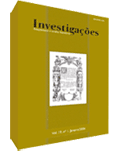Urutu: Riobaldo (mais do que)-ele-mesmo
Abstract
Ao analisar como a narrativa de Riobaldo, narrador-protagonista de Grande Sertão: Veredas, deixa entrever as oscilações na trajetória de uma individualidade que busca reconhecer-se como tal, assim como superar as imposições de uma mentalidade de grupo (representada, no livro, pelas figuras dos jagunços e de seus chefes), este trabalho pretende fazer aproximações do romance de Guimarães Rosa com a poesia de William Blake, em Marriage Between Heaven and Hell,e o pensamento do filósofo Max Stirner, sempre tendo em vista os mecanismos utilizados pelo ego consciente para a obtenção da liberdade individual.References
ALIGHIERI, Dante. 2005. A Divina Comédia. trad. Vasco da Graça
Moura. São Paulo: Landmark.
BLAKE, William.1996. Selected poetry. New York: Oxford University
Press.
BLOOM, Harold. 1974. Los poetas visionarios del romantismo ingles.
Barcelona: Barral.
CANDIDO, Antonio. 1983. O homem dos avessos. In: – COUTINHO, Eduardo F. (org.). Guimarães Rosa: coleção fortuna crítica. Rio de Janeiro: Civilização Brasileira, pgs 294 - 309.
ELIOT, T.S. 2004. Poesia. trad. Ivan Junqueira. São Paulo: Arx.
GASSET, José Ortega y,. 1967. Meditações do Quixote. São Paulo,
Livraria Ibero-Americana.
MALLARMÉ, Stéphane. 2007. Poésies. Saint-Armand: Gallimard.
PLATÃO. 1962. Fedro. In: – Diálogos, vol. I; trad. Jorge Paleikat.
Porto Alegre, Globo.
QUEVEDO, Francisco. 2004. Sonetos de amor y otros poemas. Buenos Aires: Longseller.
ROSA, João Guimarães. 2001. Grande Sertão: Veredas. Rio de Janeiro, Nova Fronteira.
SCHOPENHAUER, Arthur. 2005. O mundo como vontade e como
representação; trad. Jair Barbosa. São Paulo: Editora UNESP.
STIRNER, Max. 1907. The ego and his own. New York, Tucker publisher.
VALÉRY, Paul. 2006. Tel quel. Saint-Armand: Gallimard.
Downloads
Published
How to Cite
Issue
Section
License
Copyright (c) 2006 Raul Azevedo de Andrade Ferreira

This work is licensed under a Creative Commons Attribution 4.0 International License.
Authors who publish with Revista Investigações agree to the following terms:
Authors retain copyright and grant the journal right of first publication with the work simultaneously licensed under the Creative Commons Attribution 4.0 International (CC BY 4.0) license that allows others to share the work with an acknowledgement of the work's authorship and initial publication in this journal.
Authors are able to enter into separate, additional contractual arrangements for the non-exclusive distribution of the journal's published version of the work (e.g., post it to an institutional repository or publish it in a book), with an acknowledgement of its initial publication in this journal.
You are free to:
Share — copy and redistribute the material in any medium or format for any purpose, even commercially.
Adapt — remix, transform, and build upon the material for any purpose, even commercially.
The licensor cannot revoke these freedoms as long as you follow the license terms.
Under the following terms:
Attribution — You must give appropriate credit , provide a link to the license, and indicate if changes were made . You may do so in any reasonable manner, but not in any way that suggests the licensor endorses you or your use.
No additional restrictions — You may not apply legal terms or technological measures that legally restrict others from doing anything the license permits.

